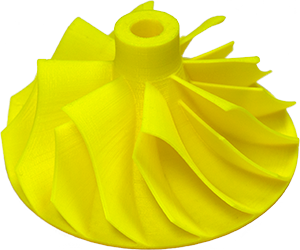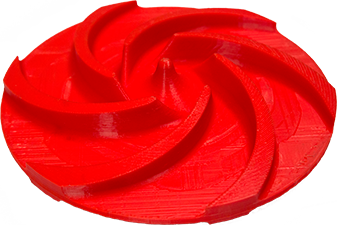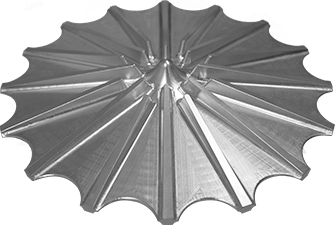For nearly a century, Wilfley has relied on precision tools and time-honored craftsmanship of engineers and tradesmen to create and produce its unparalleled products. Coming from such a tenured position in the industry, we tend to be cautious but timely adopters of new technology. In Quality, we rely on an articulating, 6-axis Coordinate Measuring Machine (CMM) capable of 0.0006” (0.014mm) repeatability for high accuracy inspection of extremely contoured geometries. Computational Fluid Dynamics software has been used in Engineering for developing high efficiency, high wear impeller, expellers and volutes. And most recently, we’ve delved into the growing world of 3D printing for rapid prototyping.

3D Printed Turbine
There have been many news articles highlighting the rapid development of 3-dimensional printers – the “Star Trek” – like ability to physically produce an object straight from your computer. The technology has been commercially viable for well over a decade, with specialty job shops ready and willing to receive your electronic files and mail you a part in 3 days. Now, the industry has evolved to offer “mini-printers” with a footprint nearly equal to that of the ubiquitous all-in-one inkjet printer/fax/copier. Fortunately, the technology is finally reaching economies of scale that make it feasible for niche companies to take advantage.

Polymer Prototype
3D printing as a means of production – commonly referred to as “Additive Manufacturing” – is still not economically viable for most mainstream products just yet. But for rapid product development, R&D and one-off production fixtures, it has proven itself to be extremely useful. Take for instance a typical centrifugal impeller. Previously prototyping would typically involve cutting aluminum alloys in a CNC machine – aka Subtractive Manufacturing. Add up the raw materials required, programing time and machining time both money and time could add up quickly – $2,000 and 2 weeks pass before you know it. Contrast that with approximately $25 worth of polymer and 18 hours of print time on a 3D printer.

Aluminum Prototype
To be fair, plastics are much weaker (8,000 psi / 56 MPa versus 40,000 psi / 276 MPa tensile strength) and not quite as dimensionally accurate as a CNC milled part from billet. However, the ability to physically examine and empirically test a variety of parts, especially with complex shapes in shorter time with less money involved is very valuable; and well suited for weeding out which designs make the CNC grade.
